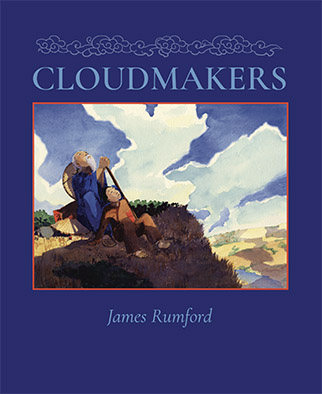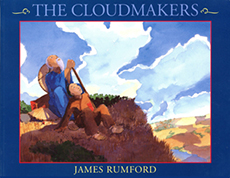My First Children's Book

This is the author's edition. To purchase a copy, click here.
The Cloudmakers was written in praise of paper. To us, paper is taken for granted: the source of junk mail, the pulp of fiction, the stuff that litters our daily lives. But to the Chinese, paper is a source of pride. Almost every Chinese history book begins with: “Paper is our country’s greatest invention.”
Paper is magic . . . at least the making of it. While it might seem a miracle that a grandfather can turn shoes into clouds, as in the story, it is no less a miracle to watch plant fibers being made into paper. When I tell the story of The Cloudmakers, I often make paper. I am always amazed at the audience’s reaction. They are as surprised as the Arabs were when they first saw paper being made 1,250 years ago.
Equally surprising to the reader is the notion that paper does not have to be made from trees. It can be made from plants such as hemp. This is often a revelation to the reader, who may, for the first time, consider alternative sources of paper fiber which do not contribute to deforestation and water pollution.
Implicit in The Cloudmakers is a story of how technology spreads from one country to the next, how ideas are diffused, how people’s lives can be improved by learning from others. The Cloudmakers also talks about how technological information is shared on a more personal level: grandfather teaches grandson. Thus, knowledge is passed on from one generation to the next. Until recently, this kind of apprenticeship—learning by doing—was the only way that information was handed down. In this day of homogenized lessons and cold, computer learning, it is well to remember how human beings have always been taught, by watching and doing, by a touch and a smile, by a grandfather who can capture a child’s imagination by turning paper making into cloudmaking.
How I wrote the story in this book: When I told Harriett Oberhaus the story, I remember seeing at the very onset how the story was going to ‘work.’ In other words, I could see its structure before I could see the words.
Structure is very important. It is the framework of 2 x 4’s that holds a house together, it is the pattern of darks and lights inherent in every painting. If the structure of a story is not right, no amount of fancy words will fix it. The same with a painting. Fancy brushstrokes and wonderful color harmonies will not fix it. Everyone knows this.
There seem to be a limited number of dark and light patterns for paintings; so I suspect that there are also a limited number of story structures, especially in a children’s picture book where the author has just thirty-two pages to get his or her message across.
In The Cloudmakers, the structure was simple: I built the story upon the seven days of the week and related the different steps in making paper to those seven days. This structure seemed an easy way to tell children about the complicated process of paper making and at the same time to relate the events of 751 AD, when the technology passed from the Chinese to the Arabs after the Battle of the Talas River.
I think that a simple story structure is the key to explaining complicated ideas, processes, or events to children. In The Island-below-the-Star, I decided that each of the five brothers would represent a different aspect of Polynesian navigation. For example, Hōkū represented the importance of knowing astronomy. Nāʻale represented the currents of the sea and its waves. Makani represented the winds, and so on and so forth. In Nine Animals and the Well, I used the ten number signs from 1 to 9 + 0 to build my story of nine animals who are invited to a raja’s birthday party. This is perhaps the clearest and easiest example of what I mean by structure: the first animal brings one present, the second animal brings two until they have nothing, due to their own foolishness.
I have perhaps misused the word ‘structure.’ Usually, for story writing, authors talk of chronological structure or steps in a procedure or cause and effect. They might even mention more complicated ideas like inference and deduction. These are all big ideas and are very useful, but what I am talking about here are structures that are easily visible to children—like the days of the week, or five brothers, or the ten number signs. These simple structures are what make for powerful stories. For more complicated structures, see Beowulf.

